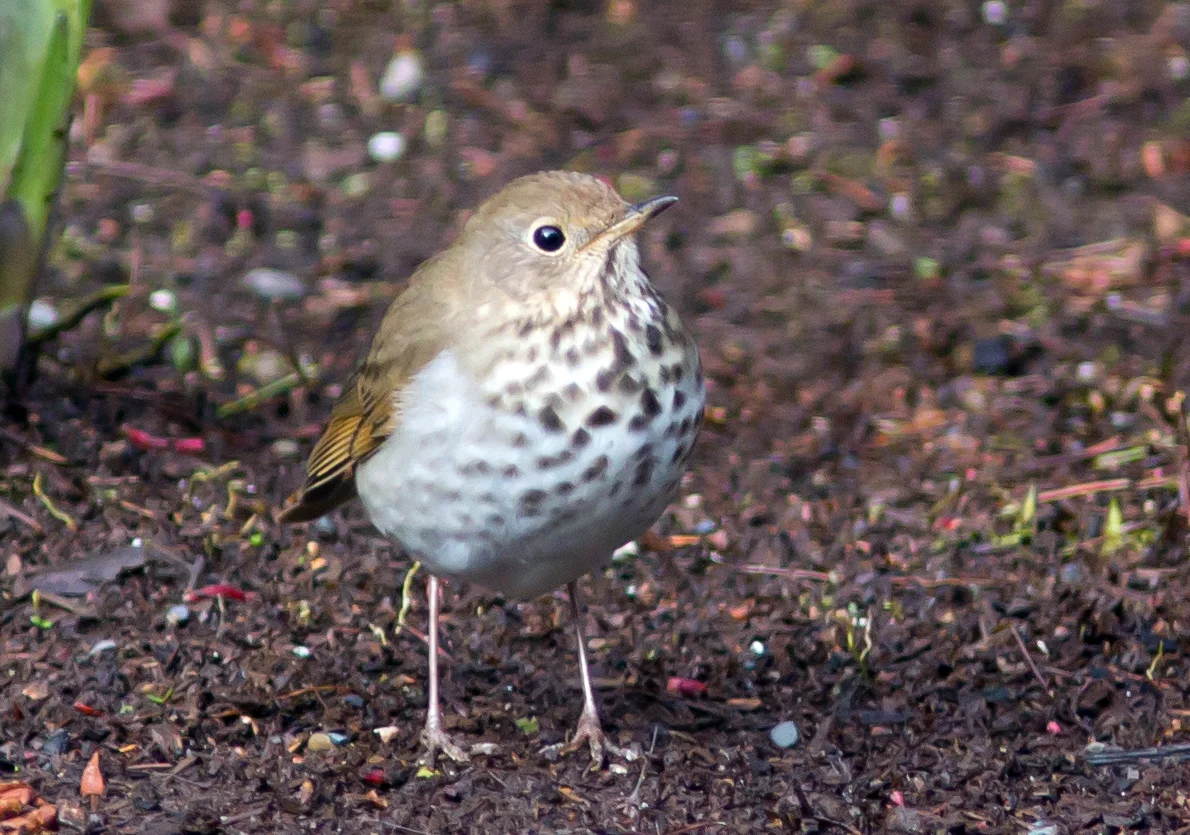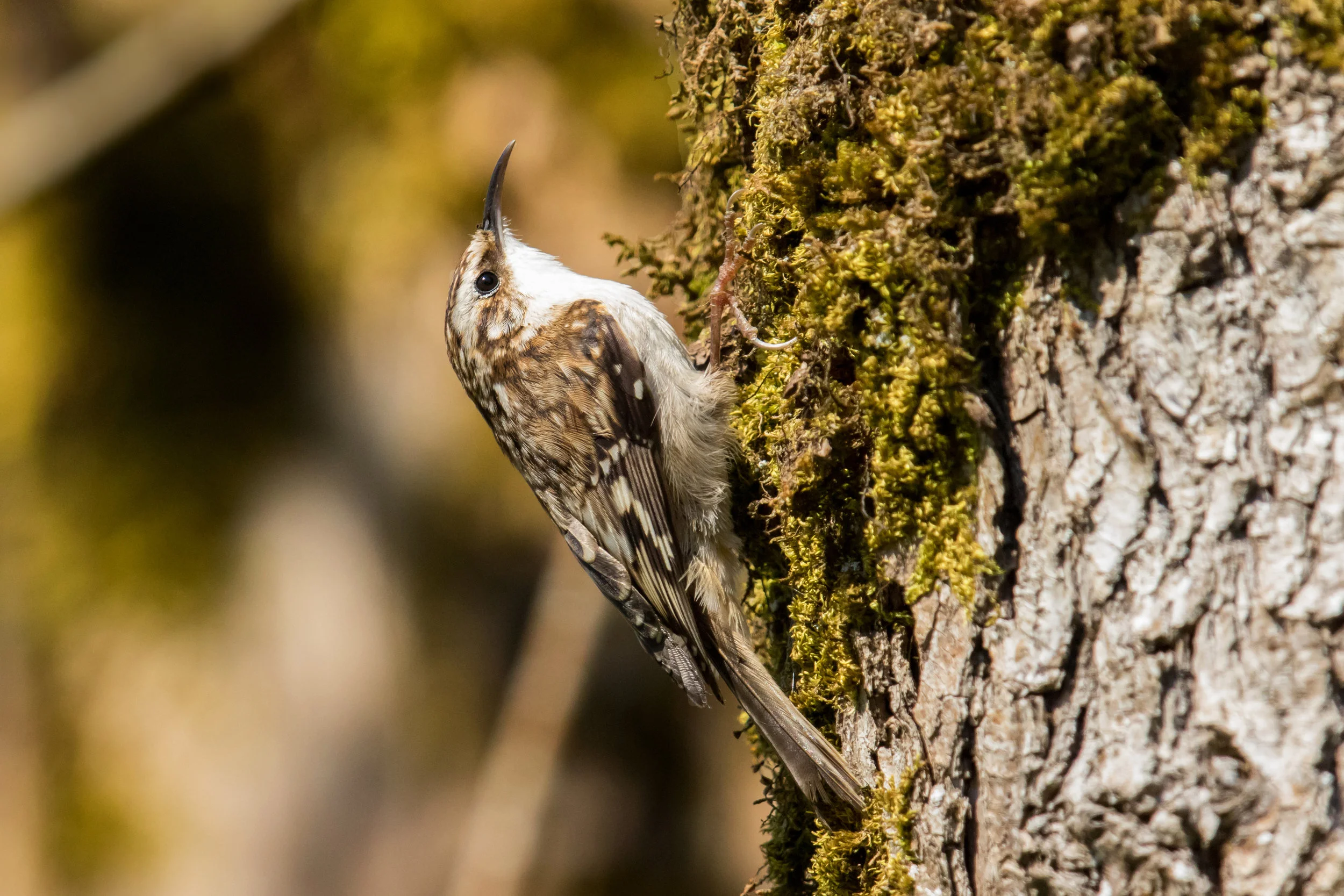Gallery - Woodland Birds
A western specialty, the Bushtit, weighing only 5 grams, is a tiny gray bird that travels in flocks when not breeding.
A bird of brushy habitats, Bewick’s Wren produces a melodious song described by Robert Ridgway as “one of the sweetest songs that ever was heard.”
An uncommon member of the thrush family, Townsend’s Solitaire breeds in higher elevations in Oregon, Washington, and British Columbia.
The Golden-crowned Kinglet is a tiny bird of conifer forests that has a yellow, black, and white head pattern. It spends most of its time in the upper reaches of pine, spruce, and cedar trees.
A thrush which favors young, wet woodland, the Veery is a retiring bird with an ethereal song that is most often heard well before the bird is seen.
The Bohemian Waxwing is the wandering relative of the wider waxwing family and it winters in Washington.
A bird has a sleek crest, a black mask across the silky brown face, a berry in its mouth, and a yellow band across the tip of its tail. It must be a Cedar Waxwing!
The Rock Wren is a bird of arid, rocky country where its ringing song echoes off rocky cliffs and canyon walls.
A bird of open woodland, the Western Bluebird brings a special beauty to the Washington landscape.
The big song of the little Pacific Wren is familiar in the old-growth forests of the Pacific Northwest.
Although seen most often in winter, the Varied Thrush is a breeding bird of the Olympics and Cascades and may also be found in the Blue Mountains of southeast Washington.
The loud yank, yank, yank call of the Red-breasted Nuthatch is often heard long before the bird is seen.
Anyone who has grown up in the eastern United States knows about the Baltimore Oriole as a woodland and garden bird and the mascot of the baseball team with the same name. Less well known, however, is Bullock’s Oriole, the western North American counterpart to the Baltimore Oriole Icterus galbula.
A vibrant tiny grayish bird of the forest, the Ruby-crowned Kinglet maintains a high activity level, lots of chatter, and a swift, erratic flight.
If you are in this small bird’s primary habitat, which is long-needled pine forests such as Ponderosa Pine, you should be able to find it fairly easily because of its hyperactive behavior and incessant and distinctive three note call.
It is found only along fast-flowing, rocky streams in the western United States and Canada. Generally non-migratory, but may descend to lower elevations in winter. It is the only truly aquatic songbird (it swims underwater) and has no other close relatives in North America
The cascading song of the Canyon Wren descends from cliffs and canyon walls, and is surely not forgotten once heard. It is most often heard in spring, but there are times when a mated pair will sing spontaneously at other times of year.
Like some little mountain spring … this little wren’s song bubbles, ripples, cascades in a miniature torrent of ecstasy (Blanchan 1903).
The Winter Wren is a small, 4” to 4 ½”, round, dark wren, smaller than the more common Bewick’s Wren. It has a very short tail, a light line over the eye, and brownish, heavily barred flanks. It often bobs and bows.
Clark’s Nutcracker was named for Captain William Clark by Alexander Wilson who analyzed the skin brought to him following the Lewis and Clark Expedition. Clark initially thought the bird was a species of woodpecker but later it was classified as a jay.
The Bushtit (BUSH) is the smallest of the N. American titmouse family at 3-1/2 to 4" long. All males and newly hatched young have dark eyes while adult females have light cream-colored eyes.
The Mountain Bluebird, sometimes called the “prairie bluebird” (Dunne), is a bird of open grasslands. It is seen most frequently in Central and Eastern Washington. It enjoys a wide range of habitats including an altitudinal range from grasslands to open areas in forests, to alpine tundra (Alderfer).
Its genus Parus comes from the Latin for titmouse and the species rufescens is from the Latin for "to become reddish". It is the most brightly colored chickadee.
The Red-eyed Vireo (REVI) is about 6” long with a wingspan of 10”. The genus name Vireo (VIH-ree-oh) is from Latin vireo, a kind of bird; according to some , the green finch; virere, to be green. The species name olivaceus (ol-ih-VAY-see-us) is Latin, olive-colored; green obscured with neutral tint.
The Hutton’s Vireo (HUVI) is 4-1/2 to 5" long with a wingspan of 8". The genus name Vireo is from the Latin meaning a kind of bird. The species name huttoni was given in 1851 by John Cassin, Philadelphia ornithologist, for William Hutton, a field collector of birds, about whom little is known
The Warbling Vireo (WAVI) is about 5.5” long. Its genus Vireo is from Latin meaning ‘a kind of bird.’ The species name is also Latin for ‘pale yellow’. It is the grayest and palest of our vireos with no wing bars, with the only head marking being an indistinct stripe over the eyes. It has a whitish breast which sometimes has a yellowish wash.
“I pause reverently as the hush and stillness of the twilight come upon the woods… And as the hermit’s evening hymn goes up from the deep solitude below me, I experience that serene exaltation of sentiment of which music, literature, and religion are but faint types and symbols” (Burroughs).
The Swainson’s Thrush (SWTH) is 7 to 7-1/2 inches long. They are fairly common in the summer, usually arriving in our area from the middle of May to June. They head south in late summer for Mexico and South America.
The Brown Creeper (BRCR) is about 5 - 5-1/2" long and is camouflaged with brown streaked plumage above and dull white below. It has a relatively long downcurved bill and long, pointed tail feathers. Creepers spiral upward from the base to the branches of a tree, then will fly to a lower place on another tree, probing bark for insects and larvae.
The Black-capped Chickadee is the most common and widespread of the chickadees and is easily identified by the average person.






























